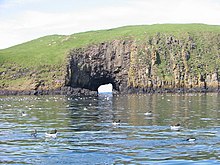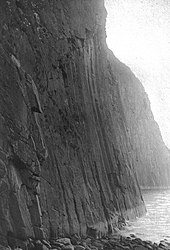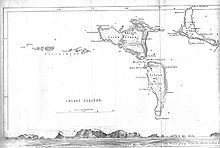
The Shiant Islands (/ʃænt/; Scottish Gaelic: Na h-Eileanan Mòra [nə ˈhelanən ˈmoːɾə] or Na h-Eileanan Seunta [nə ˈhelanən ˈʃiant̪ə] ) or Shiant Isles are a privately owned island group in the Minch, east of Harris in the Outer Hebrides of Scotland. They are five miles (eight kilometres) southeast of the Isle of Lewis.
Etymology
The name Shiant is from the Scottish Gaelic Na h-Eileanan Seunta, which means the "charmed", "holy" or "enchanted isles". The group is also known as Na h-Eileanan Mòra, "the big isles". The main islands are Garbh Eilean ("rough island") and Eilean an Taighe ("house island"), which are joined by a narrow isthmus, and Eilean Mhuire ("island of the Virgin Mary") to the east. Eilean an Taighe was called Eilean na Cille ("island of the church") prior to the 19th century.
A 17th-century chart by John Adair and several other 18th-century charts call Garbh Eilean Nunaltins Isle, Eilean Mhuire St Marys Isle and Eilean an Taighe St Columbs Isle. This last name suggests that the chapel on Eilean an Taighe might have been dedicated to St Columba. The meaning of Nunaltins remains unclear.
Geography and geology

The Shiant Islands lie east of the Sound of Shiant. Garbh Eilean and Eilean an Taighe together extend to 143 hectares (350 acres); the much more fertile Eilean Mhuire extends to 75 hectares (190 acres). In addition to these main islands, there is a line of Galtachan rocks that lie to the west: Galta Beag, Bodach, Stacan Laidir, Galta Mòr, Sgeir Mhic a' Ghobha and Damhag.
Geologically, these islands are an extension of the Trotternish peninsula of Skye. Their rocks are volcanic, and, at 60 million years old, very young compared with other Hebridean rocks. Dolerite columns on the north side of Garbh Eilean are over 120 metres (390 feet) tall and about 2 m (6 ft 7 in) in diameter. They are much higher in places than those at Staffa and the Giant's Causeway, but similar in that they were formed by the slow cooling of volcanic rocks deep underground. Intrusive sills exhibit a progression in their chemical compositions, from olivine-rich rocks at the base, to rocks with very little or no olivine at the top.
The sills are thought to have been formed by crystal settling. Recent study has suggested that at least one of the sills is an example of a multiple intrusion. In some places, the basalt is overlain by Jurassic mudstone, which weathers to form much more fertile soil than is present elsewhere in the Western Isles.
The islands can be visited by means of various cruise ships that operate from other Hebridean Islands and from mainland Scotland. Small boat (RIBs) tours out to the islands are also run by operators from the Outer Hebrides.

History

In 1549, Donald Monro, Dean of the Isles wrote in Scots of:
"an isle called Ellan Senta, which means in English "fable island", an isle more than two miles long, very profitable for grain, stock-rearing and fishing, pertaining to McLeod of Lewis. On the east side of this isle there is a bore, made like a vault, longer(?) than the arrow shot of any man on earth, through which gulping vault we used to row our sail boats, for fear of the horrible break of the seas that is on the outward side, but no large ship can sail through it." Nicolson (2002) calls this "vault" on Toll a' Roimh at the north east end of Garbh Eilean the "Hole of the Seals" and describes rowing a dinghy through it.

A century and a half later, in 1703, Martin Martin wrote that
the two southern islands are separated only by spring-tides, and are two miles in circumference. Island-More hath a chapel in it dedicated to the Virgin Mary, and is fruitful in corn and grass; the island joining to it on the west is only for pasturage.
At the beginning of the twentieth century, the Shiant Islands were home to only eight people. The author and politician Compton MacKenzie owned the islands from 1925 until 1937. He was an island lover who, at different points in his life, also occasionally rented Herm in the Channel Islands. He never lived on the Shiants, but paid several brief visits there during his time as owner.
In 1937, the islands were purchased by Nigel Nicolson, then an undergraduate at Oxford, using money that had been left to him by his grandmother. Nicolson later became a writer, publisher and politician, as MacKenzie had been. Nicolson's son, the writer Adam Nicolson, published the definitive book on the islands, Sea Room (2001). Today, the Shiants belong to Adam's son, Tom Nicolson. Sheep continue to graze the islands, as they have done since the mid-19th century. The simple bothy maintained by the Nicolson family on Eilean an Taighe is the only habitable structure on any of the islands. In 2012, Robert Macfarlane published, in The Old Ways, a description of his visit to the islands.
Wildlife
Main article: Nature of the Outer Hebrides

The Shiant Islands have a large population of seabirds, including tens of thousands of Atlantic puffins that breed in burrows on the slopes of Garbh Eilean, and significant numbers of common guillemots, razorbills, northern fulmars, black-legged kittiwakes, common shags, gulls and great skuas. (There are fewer puffins on Garbh Eilean than on the remote island of St Kilda, but they are much more densely congregated.)
Until recently, the islands were also home to a population of black rats, Rattus rattus, which are presumed to have originally come ashore from a shipwreck. Apart from one or two small islands in the Firth of Forth, the Shiants were the only place in the UK where the black rat (or ship rat) could still be found. There was thought to be a population of about 3,500 rats on the islands in wintertime, with their numbers rising exponentially during the summer. Analysis of their stomach contents had shown that they ate seabirds, but it could not be determined whether they preyed on live birds or simply scavenged dead ones. (Their numbers had for many years been well controlled in and around the house.)
During the winter of 2015–2016, Wildlife Management International Limited initiated a project to permanently eradicate rats from the Shiant Islands, as part of the Shiant Isles Seabird Recovery Project. The project was funded by contributions from the EU, the SNH, the RSPB and many individual donors. In March 2018, the Shiant Islands were deemed to have satisfactorily completed the internationally agreed two-year eradication period, and were officially declared rat-free.
The waters around the Shiant Islands are home to a fantastic variety of marine wildlife including grey and harbour seals, fin whales, killer whales, dolphins, basking sharks, porpoises.
See also
References
Notes
- Nicolson (2002) adds "hallowed", "haunted", "spooky" and "otherworldly" to the possible meanings of sénta, the Irish equivalent of the Scottish Gaelic sianta.
- Translation from Scots: "ane ile callit Ellan Senta, that is in English a Saw, ane ile mair than twa myle lang, verey profitable for corne, store, and fishing, perteining to M’Cloyd of the Lewis. On the eist side of this ile ther is a bore, maid like a vylt, mair nore an arrow shot of any man under the eirde, through the quilk vylt we use to row ore saill with our bottis, for fear of the horrible breake of the seas that is on the outward side thereof, bot na grate ships can saill ther." Nicolson (2002) calls this "vault" on Toll a' Roimh at the north east end of Garbh Eilean the "Hole of the Seals" and describes rowing a dinghy through it.
- Martin's poor grasp of the geography contributed to later confusion. "Island-More" must be his translation of Na h-Eileanan Mòra and there was a chapel on Eilean an Taighe (known as Eilean na Cille at the time he was writing). The "island joining to it on the west" must therefore be Garbh Eilean to the north. Martin's description has led to suggestions that the chapel was on Eilean Mhuire, although this seems unlikely.
Footnotes
- "Shiant Islands/Na h-Eileanan Mтra". Ordnance Survey. Retrieved 7 February 2019.
- ^ Keay, J. & Keay, J. (1994) Collins Encyclopaedia of Scotland. London. HarperCollins.
- ^ Haswell-Smith (2004) pp. 275-76
- Mac an Tàilleir (2003) p. 105
- Nicolson (2002) p. 72
- John N. Moore, 'John Adair's Contribution to the Charting of the Scottish Coasts: A Re-Assessment', Imago Mundi, Vol. 52 (2000), pp. 43–65)
- Nicolson (2002) p. 143
- Get-a-map. Ordnance Survey. Retrieved 10 April 2011.
- ^ "Western Isles Guide Book: Shiant Islands". Retrieved 21 July 2007.
- Kathryn Goodenough (September 1999). "Geological Conservation Review: Shiant Isles SSSI" (PDF). Scottish Natural Heritage. Retrieved 21 July 2007.
- Monro (1594) "Ila" No. 175
- Nicolson (2002) p. 217
- Nicolson (2002) pp. 73, 78
- Martin (1703) p. 35
- Nicolson (2002) p. 144
- Nicolson, Adam Sea Room: An Island Life in the Hebrides HarperCollins, 2001 (ISBN 0-00-257164-1)
- Macfarlane, Robert (2012) The Old Ways Hamish Hamilton.
- Harvie-Brown, J. A. & Buckley, T. E. (1889), A Vertebrate Fauna of the Outer Hebrides. Pub. David Douglas, Edinburgh. Facing P. XIV.
- "Birds of the Shiant Islands: 1970 & 1971 census". Shiant Islands. Archived from the original on 2 July 2007. Retrieved 21 July 2007.
- Haswell-Smith (2004) pp. 276-77
- "Developing a mammal monitoring programme for the UK" (PDF). Joint Nature Conservation Committee. Retrieved 2 January 2007.
- Stapp, Paul (2002) "Stable isotopes reveal evidence of predation by ship rats on seabirds on the Shiant Islands". Scotland Journal of Applied Ecology 39 (5), 831–840.
- A. Nicolson, personal comment.
- "Black rat cull project on Shiant Islands gets EU funding". BBC News. 9 June 2014. Retrieved 4 April 2017.
- McKenzie, Steven (16 June 2014). "Super infuriating animals? The business of tackling unwelcome animals". BBC News. Retrieved 4 April 2017.
- "EU gives £450,000 to project aiming to clear islands of rats". The Herald. 7 June 2014. Retrieved 4 April 2017.
- "Shiant Islands in the Minch declared rat-free". BBC News. BBC. 2 March 2018. Retrieved 2 March 2018.
- Kristin (19 April 2021). "Wildlife Watching At the Shiants in the Outer Hebrides". Adventures with Ensuite. Retrieved 4 June 2023.
- "Navigation and wildlife observation in the Shiant Archipelago • EnezGreen". EnezGreen. 26 June 2015. Retrieved 4 June 2023.
General references
- Benvie, Niall (2004). Scotland's Wildlife. Aurum Press. ISBN 1-85410-978-2.
- Haswell-Smith, Hamish (2004). The Scottish Islands. Edinburgh: Canongate. ISBN 978-1-84195-454-7.
- Mac an Tàilleir, Iain (2003) Placenames/Ainmean-àite le buidheachas (pdf). Pàrlamaid na h-Alba. Retrieved 6 October 2009.
- Martin, Martin (1703) A Description of The Western Islands of Scotland (Circa 1695) . Appin Regiment/Appin Historical Society. Retrieved 3 March 2007
- Monro, Sir Donald (1549) Description of the Western Isles of Scotland. William Auld. Edinburgh - 1774 edition.
- Nicolson, Adam (2002) Sea Room. London. HarperCollins. ISBN 0-00-653201-2
External links
| Shiant Islands (Na h-Eileanan Seunta), Outer Hebrides | |
|---|---|
| Inhabited islands of the Hebrides | ||
|---|---|---|
| Inner Hebrides |  | |
| Outer Hebrides | ||
57°53′56″N 6°21′51″W / 57.8990°N 6.3641°W / 57.8990; -6.3641
Categories: